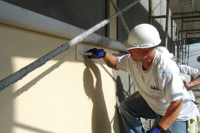It is common knowledge that a lot of people are resistant to change. However, refusing to change or adapt may force a worse alternative. Some plastering contractors do not like one-coat stucco. One-coat stucco was born out of the 1970 energy crisis. Codes increased the R-value for homes requiring builders to use 2x6 framing. The added cavity space allowed for more batt insulation to meet the new code. Stucco manufacturers responded with a one-coat stucco system over 1-inch rigid foam so builders could stay with 2x4s. Most plastering contractors resisted the new stucco—I know I did. We liked three-coat.
One re-occurring issue was having a builder call to request a re-bid on his project for one-coat stucco. The builder was led to believe one-coat was cheaper than three-coat and could save him money. The explanations were that there was no real savings. It seemed counter-intuitive and led them to distrust me as a contractor. After all, no scratch coat, shorter scaffold rental and less masking all had to result in a lower price, right? Not really and here is why.
Less Masking: Plastering contractors do not mask for each coat. There are no savings.
Shorter Scaffold Rental: Most contractors rent scaffolding on a five to six week turnaround basis. Shaving a few days is not really a factor. It would be hard to calculate the savings in capital investment or additional potential revenue. Assuming scaffolding is up 100 percent of the time is unrealistic. Rarely does a scaffold go from one job straight to the next. Trucks are typically loaded specifically for projects with unique needs.
No Scratch Coat: While true and measurable, the calculated labor savings of this type of coat is generally offset by the cost of the code approved one-coat material. Another issue is that a brown coat over a set scratch coat is friendlier to work with. This results in slightly higher and better production on brown coat over a scratch coat, as compared to the single-basecoat over a rigid foam base.
Most plastering contractors agree that with regard to cost comparison, one-coat and three-coat are about the same. Yet, if I were contracting today, I would prefer to use one-coat stucco.
The code is moving hard and fast to mandate continuous insulation on exteriors. While CI is possible with generic stucco, is there adequate testing and back-up data to support three-coat over stucco? Add in litigation concerns and the back-up of the evaluation reports is a powerful ally to verify compliance to the building codes. One-coat stucco over rigid foam has been tested for fire, lateral, wind and water intrusion. The reports also help with guidance on installation. With regard to code compliance, you have stronger backing with an approved one-coat.
Defect Litigation
Defect litigation is still big business. Plaintiffs make interpretations on installations based on various codes and standards. You probably know more about stucco than they do but they can be convincing at making a contractor look like they deviated or even cheated on codes or standards. With one-coat stucco, the system is proprietary and the manufacturer of that system has the authority. That can be a powerful tool on your side. Even on the front end, installation or detail conflicts are a daily challenge. Recommendations from the manufacturer generally prevail over consultant’s recommendations.
History
We also do not want to repeat history. Gypsum lath and plaster was once king. Drywall made plaster near obsolete in a single decade. Manufacturers developed a skim coat plaster called veneer plaster to compete with drywall.
The plaster or stucco industry should look again at one-coat stucco and consider the benefits and alternatives. It should not be about saving money or cutting costs. It should be about maintaining market share and giving customers what they want; an affordable quality cladding that meets codes.
Rigid foam will be used on exteriors as we move ahead. Architects and designers like and want stucco on their buildings. One-coat stucco manufacturers have handed contractors a system that is tested, proven, 100 percent code compliant and designed specifically for application over tongue and groove rigid foam sheets. Hearing that contractors refuse to put stucco over foam or attempt to force designers to what they want is a kiss of death. Our fathers lost inside plaster on buildings—are we poised to lose the outside? Other claddings are betting we will.










